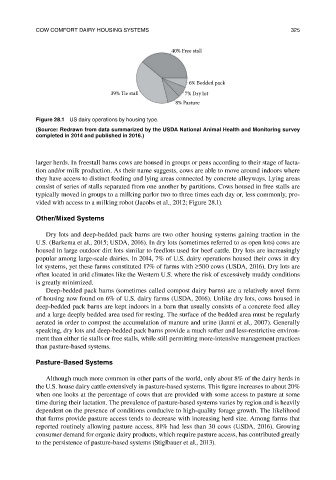Page 348 - The Welfare of Cattle
P. 348
CoW CoMfort daIrY housInG sYsteMs 325
40% Free stall
6% Bedded pack
39% Tie stall 7% Dry lot
8% Pasture
Figure 28.1 us dairy operations by housing type.
(Source: redrawn from data summarized by the USDa National animal health and Monitoring survey
completed in 2014 and published in 2016.)
larger herds. In freestall barns cows are housed in groups or pens according to their stage of lacta-
tion and/or milk production. As their name suggests, cows are able to move around indoors where
they have access to distinct feeding and lying areas connected by concrete alleyways. Lying areas
consist of series of stalls separated from one another by partitions. Cows housed in free stalls are
typically moved in groups to a milking parlor two to three times each day or, less commonly, pro-
vided with access to a milking robot (Jacobs et al., 2012; Figure 28.1).
Other/Mixed Systems
Dry lots and deep-bedded pack barns are two other housing systems gaining traction in the
U.S. (Barkema et al., 2015; USDA, 2016). In dry lots (sometimes referred to as open lots) cows are
housed in large outdoor dirt lots similar to feedlots used for beef cattle. Dry lots are increasingly
popular among large-scale dairies. In 2014, 7% of U.S. dairy operations housed their cows in dry
lot systems, yet these farms constituted 17% of farms with ≥500 cows (USDA, 2016). Dry lots are
often located in arid climates like the Western U.S. where the risk of excessively muddy conditions
is greatly minimized.
Deep-bedded pack barns (sometimes called compost dairy barns) are a relatively novel form
of housing now found on 6% of U.S. dairy farms (USDA, 2016). Unlike dry lots, cows housed in
deep-bedded pack barns are kept indoors in a barn that usually consists of a concrete feed alley
and a large deeply bedded area used for resting. The surface of the bedded area must be regularly
aerated in order to compost the accumulation of manure and urine (Janni et al., 2007). Generally
speaking, dry lots and deep-bedded pack barns provide a much softer and less-restrictive environ-
ment than either tie stalls or free stalls, while still permitting more-intensive management practices
than pasture-based systems.
Pasture-Based Systems
Although much more common in other parts of the world, only about 8% of the dairy herds in
the U.S. house dairy cattle extensively in pasture-based systems. This figure increases to about 20%
when one looks at the percentage of cows that are provided with some access to pasture at some
time during their lactation. The prevalence of pasture-based systems varies by region and is heavily
dependent on the presence of conditions conducive to high-quality forage growth. The likelihood
that farms provide pasture access tends to decrease with increasing herd size. Among farms that
reported routinely allowing pasture access, 81% had less than 30 cows (USDA, 2016). Growing
consumer demand for organic dairy products, which require pasture access, has contributed greatly
to the persistence of pasture-based systems (Stiglbauer et al., 2013).

